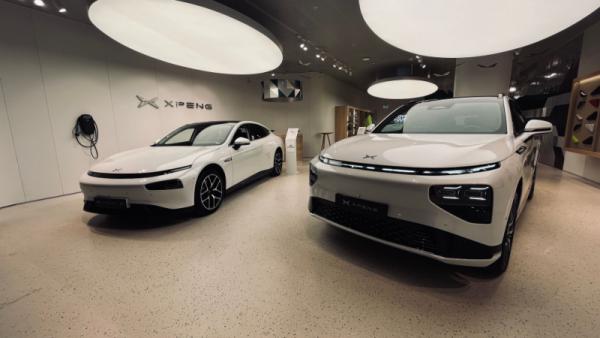Basel Al seoufi / Shutterstock

Marina Yue Zhang, Associate Professor – Research, Australia-China Relations Institute, University of Technology Sydney |
This article appeared in the East Asia Forum on November 29 2023.
Japanese automaker Mitsubishi Motors announced in October 2023 it was pulling out of a joint venture with the Guangzhou Automobile Group (GAC) amid declining sales and fierce competition from electric and hybrid vehicles. The decision highlights the broader challenges that foreign automakers face in China and the significant shifts in the global automotive sector.
GAC is one of China’s leading automotive manufacturers that serves as a local partner for several Japanese automakers, including Toyota, Honda and Subaru. These joint ventures have enhanced GAC’s production capabilities while opening up China’s vast car market to foreign manufacturers. This collaboration aligns with the government’s ‘technology for market‘ strategy, introduced in the 1990s to bolster its domestic automobile industry.
Auto production surged as a result, climbing from a mere 500,000 units in 1998 to over 10 million by 2009, and will likely reach 30 million by the end of 2023. Electric vehicles (EVs) have fuelled much of this growth. China is the world’s leading EV producer and boasts the largest EV market, accounting for nearly 60 percent of all EVs globally. The country’s stronghold on sector patents and dominance in battery supplies further solidifies its position.
Mitsubishi’s departure from China is a consequence of this market shift away from traditional combustion engine vehicles. As China becomes a prominent player in EV supply chains and production, it could disrupt nations reliant on the automobile manufacturing industry, as well as the embedded networks of component and parts suppliers.
Outside the mid-to-high-end market segments, foreign automakers face significant pressure from domestic competition. By September 2022, about 50 percent of the vehicles on China’s roads were from foreign brands, down from 62 percent in 2020 and 56 percent in 2021. EVs are largely responsible for this reallocation, which aligns with China’s goals of bolstering energy security, cutting down on carbon emissions and carving out a niche for indigenous auto brands.
The government rolled out a subsidy scheme for EVs in 2009, catapulting EV sales from a mere 5000 units to an impressive 6.89 million in 2022. These subsidies supported production through direct financial backing, R&D investments and energy credits for EV manufacturers. China also targeted the consumer side, offering benefits like tax rebates and priority license plates for EV purchasers.
The government has progressively phased out these subsidies since 2020, sidelining automakers that were heavily reliant on them. This change created an opportunity for competitive EV brands like BYD, Xpeng, Aion, Nio and Li Auto to thrive. Aion, a brand under GAC, was the third top-selling EV brand in China through the first three quarters of 2023, trailing only BYD and Tesla.
As China rises in the EV sector, numerous global carmakers have grappled with the evolving landscape. A nation’s car production capabilities reflect its advanced manufacturing acumen. But the extensive experience of Japanese car manufacturers and their established supply chains have paradoxically become somewhat of a liability, making it difficult for them to adapt swiftly to the rapid embrace of EVs.
The paradigm shifts in the automotive industry highlight the evolutionary nature of production methods. Chinese EV production, characterised by hyper-flexible, customisable, super-connected and widely distributed supply chains, might pave the way for a pioneering mode of auto production. This could mimic the paradigm shifts seen in Ford’s assembly line production or Toyota’s just-in-time strategy.
While Mitsubishi has met this challenge by exiting the market, others hope to capitalise on China’s automotive industry transformation. In 2022, Toyota and BYD launched their first jointly developed EV model. In July 2023, Volkswagen entered a technology partnership with Xpeng Motors, aiming to release two Class B EVs in China. In this ‘reverse technology transfer’ agreement, Xpeng will levy a ‘technology service fee’ on Volkswagen, marking a pivotal change in China’s auto sector.
Meanwhile, German giants like Mercedes-Benz and BMW are considering moving their European EV production to China, attracted by its technological edge and cost-efficient supply chains. According to Stellantis CEO Carlos Tavares, such a move could shave as much as 40 percent off production costs thanks to economies of scale and innovation in production.
Mitsubishi’s withdrawal from China’s thriving auto market might not stem primarily from ‘unfair’ competition with government-backed domestic brands, but rather their inability to quickly adapt to the evolving market dynamics.
Moving forward, it is crucial for China to keep its market open to foreign car manufacturers, especially in the EV sector where it has a competitive edge.
Foreign automakers must be agile and adaptive to succeed in the Chinese market. They need to adopt a pragmatic approach in their collaborative research and development (R&D) and product design endeavours with Chinese entities. Technological innovation and cost efficiency in production are driven by market scale, and China holds a dominant position in this regard.
Author
Dr Marina Yue Zhang is Associate Professor – Research at the Australia-China Relations Institute, University of Technology Sydney.


